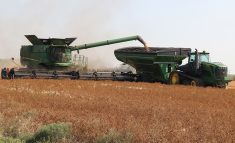When it comes to promoting safety around the farm, Kim Hobbs says producers need to be just as vigilant about fatigue as they are about drinking alcohol before driving.
“Now, we’ve all heard of Mothers Against Drunk Driving,” she told a recent webinar hosted by AgSafe Alberta. “But I’m looking forward to the day when we see Fathers Against Fatigue Driving.”
As the vice-president of In-Scope Solutions, Hobbs specializes in human risk factors in the workplace. She pointed to the long hours farmers face during fall harvest.
Read Also

Understand limitation periods if considering civil suit
A limitation period refers to the amount of time a plaintiff has to commence a formal claim in court or lose their ability to pursue it.
“And you’re saying, ‘Kim, this does not change the fact that when the sun is up and the weather is good, I have to work. I can’t sleep when I can’t sleep.’ ”
However, studies have shown that people who have experienced 17 hours of continual wakefulness function at a level equivalent to someone with a blood alcohol level of .05 percent, said Hobbs.
“Now, in Alberta, that is a three-day suspension of your driver’s license.”
People who have undergone 21 hours of wakefulness function at a level equivalent to legal impairment of .08, “so drinking and driving or fatigue driving, there is no difference.”
Producers are part of an industry described as one of the most dangerous in Canada in terms of injuries and fatalities. Add fatigue to the mix and the impact on safety becomes clear.
Part of combating fatigue involves understanding the importance of sleep, Hobbs said.
“Sleep is at the centre of everything that we do, and if we aren’t sleeping properly, fatigue implicates everything we do.”
Human beings are not naturally nocturnal, she said. Their circadian rhythm is based on being awake when it is light out and asleep during the night.
“So, when we are well rested, we are alert … We’re capable of looking across our work environment and evaluating what we need to do.”
The act of sleep involves cycling through four stages that perform essential functions in the brain, including the removal of toxins, emotional regulation and processing long-term memories. If people fall into bad habits and don’t allow this pattern to run its full course of seven to nine hours, it can lead to serious consequences.
These can include an increased risk of illness ranging from heart disease and diabetes to cancer, said Hobbs. However, among the first warning signs of fatigue are changes in emotions and behaviour.
“So, the first thing you will see is mood swings: impulsivity, somebody who is normally really vigilant from a safety perspective becomes less vigilant, maybe just doesn’t care as much. We see higher passivity, people who are just giving up; or higher levels of aggression, (and) people who become unmotivated and depressed.”
Other signs involve declining mental abilities.
“The first thing we see is your memory is impacted,” said Hobbs. “Your focus, your judgment, your decision making, your problem solving and your concentration all go down the more fatigued you are.”
It can also result in blurred vision and slower reaction times and affect balance and gross motor skills.
“And probably one of the scariest things that happens the more sleep deprived you are, is this thing called microsleeps, and this is when your brain shuts down and you don’t even know it.”
It can last from three to 10 seconds, which is long enough for drivers on highways to travel the length of a football field. It was a factor in a head-on collision in 1986 involving a freight train and a passenger train that killed 23 people near Hinton, Alta., she said.
Although alcohol is related to 38 percent of vehicle fatalities in the United States, fatigue is a factor in 21 percent, she added.
“What we (also) know statistically is 40 percent of adults are not getting enough sleep on a regular basis and 30 percent of us are getting less than six hours a night.”
People are more likely to develop problems with sleeping as they age. Sleep apnea involving snoring affects about 15 percent of the general population, along with 25 percent of men over 45 years old, so it is important to be screened for this condition, said Hobbs.
“One of the keys that you have it is you’re always exhausted. One of the precursors to it is a wide neck 17 inches or greater.”
However, night shifts are one of the biggest contributors to fatigue, along with inappropriate shift rotations and long periods of work, she said. This includes seasonal work such as agriculture.
Other risks factors for fatigue are jobs with physically or mentally demanding work requirements, as well as high stress, working from a remote location or with high travel demands.
“If you are doing monotonous work tasks, that can be a high-risk factor.”
As a result, Hobbs said it is important to practice what she called good sleep hygiene, such as making sure the room is dark by blocking light from windows, keeping temperatures cool and minimizing noise through use of earplugs if necessary.
It is also vital to avoid exercise or heavy meals late at night, along with alcohol, nicotine or caffeine. People should limit their screen time on TVs, smartphones and computers and dim their lights 30 to 60 minutes before bedtime.
“The other thing is we are creatures of habit, so keep the same schedule, have routines and practice them.”
If tired while working or driving, stopping for brief naps can help. These are particularly effective during periods of natural lows in the circadian cycle that occur between about 3 a.m. and 5 a.m., and 1:30 p.m. to 2 p.m.
It is also important to take micro breaks, such as getting up to stretch and move around, she added.


















